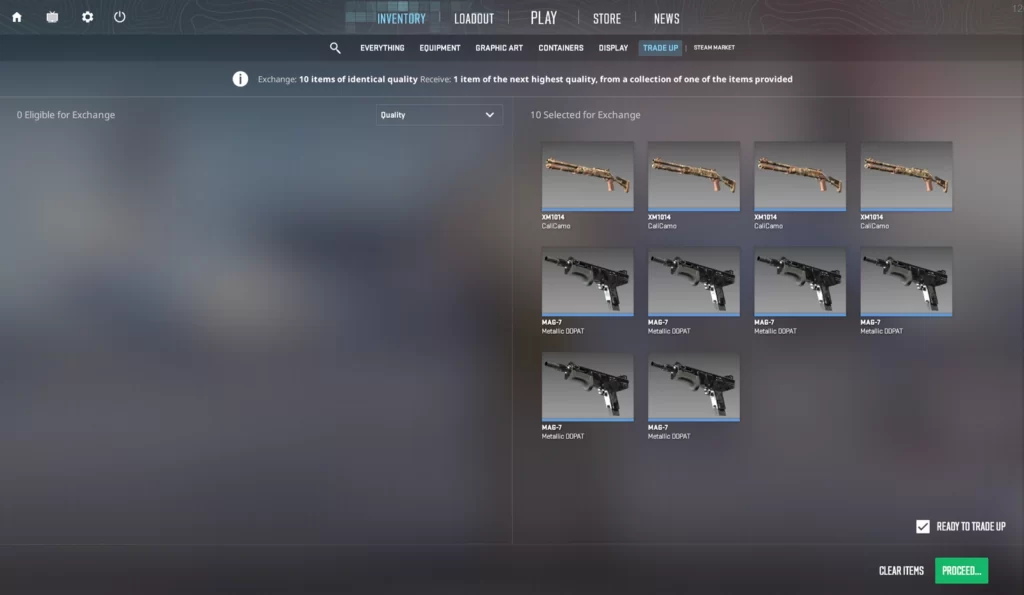79tka Insights
Your go-to source for the latest news and information.
CS2 Trade-Ups: When Risk Meets Reward in Spectacular Fashion
Discover the thrill of CS2 trade-ups! Uncover strategies to turn risks into impressive rewards while maximizing your gaming loot.
Understanding CS2 Trade-Ups: Strategies for Maximizing Your Gains
Understanding CS2 trade-ups is essential for maximizing your gains in the dynamic world of Counter-Strike 2 (CS2). This system allows players to exchange several lower-value skins for a chance at acquiring a higher-value item. The key to success in CS2 trade-ups lies in strategy and research. Start by analyzing the current market trends and skin values. Websites like CSGO Stash and Steam Community can provide valuable insights into recent price fluctuations, helping you identify which skins to trade. Consider factors such as rarity, demand, and whether a skin is in the current meta to make informed decisions.
Once you have gathered the necessary information, it’s time to consider your trade-up strategy. A popular method is to focus on collecting trade-up contracts that yield high-value outcomes. For example, you might want to target skins that are considered "blue" or "purple" on the rarity scale, as these often have more lucrative trade-up potential. Additionally, keeping track of odds and understanding the risks involved are crucial. By calculating the estimated value of your potential trade-up items and comparing it to their costs, you can significantly improve your chances of making a profit. Remember, consistency is key; the more trades you perform, the better your understanding of the market becomes.

Counter-Strike has evolved significantly since its inception, becoming a staple in the esports community. Players engage in tactical team-based gameplay where strategy and skill are paramount. One exciting aspect of the game is the CS2 Case Battles, which adds an interesting dimension to the player's experience by allowing them to compete for valuable in-game items.
The Science Behind Risk and Reward in CS2 Trade-Ups
In the world of CS2 trade-ups, the concept of risk and reward plays a pivotal role in determining the success of a player’s strategy. At its core, a trade-up contract allows players to exchange multiple lower-tier items for a single, higher-tier item. However, this comes with inherent risks. Players must carefully consider the probabilities associated with each trade-up, as the potential for obtaining a rare item often hinges on the items being sacrificed. For instance, understanding the market trends and the rarity of items can significantly impact the outcome of a trade-up, as the chances of landing a desirable skin are not merely based on luck but on informed decision-making.
Moreover, to navigate this landscape of risk, players should engage in careful planning and analysis. A well-researched approach involves calculating the expected value of a trade-up to assess whether the potential rewards outweigh the losses. Utilizing tools and calculators designed for CS2 trade-ups can provide valuable insights into which items have the highest success rates and can aid players in making decisions that align with their risk tolerance. Ultimately, understanding the science behind risk and reward in trade-ups is essential for maximizing profits and minimizing losses, turning chance into a calculated venture.
Top 5 Tips for Successful CS2 Trade-Ups: What You Need to Know
When it comes to successful CS2 trade-ups, understanding the market and knowing your items is crucial for maximizing your results. Start by researching the current CS2 skin trends and prices. Sites like Steam Analyst or CSGO Float can provide valuable insights into item values and help you identify which skins are worth trading. By keeping an eye on these trends, you can make informed decisions that increase your chances of landing highly sought-after skins.
Another key tip is to prioritize your trade-up selections. Aim for items that not only have desirable skins but also possess a higher float value, as these often result in better outcomes during trades. Consider creating a list of potential items you want to use for trade-ups, specifying their float values, and researching their market demand. This organized approach gives you a solid strategy for successful CS2 trade-ups, ensuring that you’re prepared to make the best trades possible.